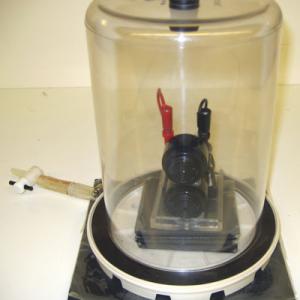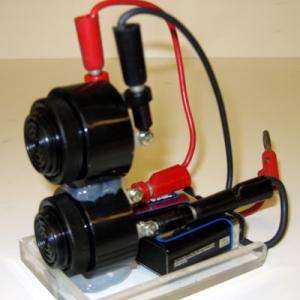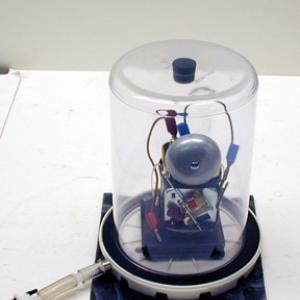College of Liberal Arts & Sciences
3B30.30 - Bell in a Vacuum
NOTE THAT THIS DEMO IS A DISCREPENT EVENT. While it is true that sound needs a medium in which to propatate, the vacuum that is normally attainable still leaves enough air in the bell jar for sound propagation. What is really happening in this demonstration is that by evacuating the bell jar you are creating an impedance mismatch between the inner and outer walls of the jar which hinders the sound propagation through the jar walls. This in turn leads to the sound going away as you create the vacuum in the bell jar. However, if you were able to stand inside the bell jar during this process, you would find that while the sound gets softer, you are still able to hear it at the maximum vacuum normally attainable.
When put into the bell jar all of the buzzers will experience a great loss of volume. Pads of sorbothane rubber are used to eliminate any vibrations. Hook the bell to 6 volt battery. With the bell ringing evacuated the bell jar with the vacuum pump. As the air is drawn from the jar the sound will diminish. With the vacuum pump running it is hard to hear the bell. The best arrangement is to put the vacuum pump in room 58 and run a vacuum hose from there into the lecture room. A switch will be needed also in the lecture room so that you can turn the pump on from there. Another alternative is to evacuate the bell jar and then shut off the pump. As you then bleed air back into the jar the buzzer will start to be heard.
- Zhang Wei, Hou Jiali, Yang Wenfang, "Mini-"Bell in a Bell Jar"", TPT, Vol. 51, # 1, Jan. 2013, p. 53.
- Christian Villa, "Bell-Jar Demonstration Using Cell Phones", TPT, Vol. 47, # 1, January 2009, p. 59.
- Clifford Swartz, "Bell in a Bell Jar - III", TPT Vol. 41, # 6, Sept. 2003, p. 317
- Dejun Han, "Improved Bell-in-a-Bell-Jar Demonstration", TPT Vol. 41, # 5, May 2003, p. 278.
- David Gavenda, "Bell in a Bell Jar - I", TPT Vol. 41, # 6, Sept. 2003, p. 316
- Burt Brody, "Bell in a Bell Jar - II", TPT Vol. 41, # 6, Sept. 2003, p. 317
- R.D. Edge, "Simple Vacuum Experiments", TPT, Vol. 25, # 8, p. 523. November 1987.
- Carl H. Hayn, "Christian Huygens and the Bell Jar", TPT, Vol. 11, # 1, Jan. 1973, p. 103.
- Leonard Eisner, "Transistor Radio in an Evacuated Bell Jar", TPT, Vol. 10, # 1, Jan. 1972, p. 47.
- Robert Frizzell, "Bell in a Vacuum Demonstration", TPT, Vol. 9, # 3, March 1971, p. 153.
- Alfred M. Eich, Jr., "Sound in Vacuum Demonstration", TPT, Vol. 6, # 8, Nov. 1968, p. 428.
- Sh- 2: Freier and Anderson, A Demonstration Handbook for Physics.
- W- 015: "Bell in Vacuum", DICK and RAE Physics Demo Notebook.
- "Tap-L Conversation on Impedance Matching Device", Sept. 2014.
- George M. Hopkins, "Gases", Experimental Science, p. 96.
- Borislaw Bilash II, David Maiullo, "Ringing Bells", A Demo a Day: A Year of Physics Demonstrations, p. 207.
- Julien Clinton Sprott, Physics Demonstrations, "3.4, Bell in Vacuum", p. 147, ISBN 0-299-21580-6.
- Ken Johns, "Does Sound Travel Through a Vacuum?", The Science Teacher, September 1989, p. 73.
- Christopher P. Jargodzki and Franklin Potter, "169, A Bell Ringing in a Bell Jar", Mad About Physics, p. 62, 206.
- Alfred M Eich, "Sound in a Vacuum Demonstration", Apparatus for Teaching Physics.
- John H. Moore, Christopher C. Davis, Michael A. Coplan, "Kinetic Theory", Building Scientific Apparatus 2nd Edition, p. 76-77.
- Raymond Bruman, "No Sound Through Empty Space", Exploratorium Cookbook I, 65.1 - 65.3.
- Robert Frizzell, "Bell in a Vacuum Demonstration", Apparatus for Teaching Physics, p. 243.
- Herb Strongin, “The Sound of Silence“, Science on a Shoestring, p. 149.
- Borislaw Bilash II, “Stop the Rattle“, A Demo A Day – A Year of Physical Science Demonstrations, p. 307.
- The Queen Catalogues Vol. II, Catalogue of Physical Instruments, No. 6491 p. 183.
Disclaimer: These demonstrations are provided only for illustrative use by persons affiliated with The University of Iowa and only under the direction of a trained instructor or physicist. The University of Iowa is not responsible for demonstrations performed by those using their own equipment or who choose to use this reference material for their own purpose. The demonstrations included here are within the public domain and can be found in materials contained in libraries, bookstores, and through electronic sources. Performing all or any portion of any of these demonstrations, with or without revisions not depicted here entails inherent risks. These risks include, without limitation, bodily injury (and possibly death), including risks to health that may be temporary or permanent and that may exacerbate a pre-existing medical condition; and property loss or damage. Anyone performing any part of these demonstrations, even with revisions, knowingly and voluntarily assumes all risks associated with them.



